Barrel pit: step-by-step master-class on arrangement
Living in a private house requires an autonomous sewage system. It consists of an internal wiring, an external pipeline, and a drive (or VOC). For residents of summer cottages or houses of temporary (seasonal) residence, a cesspool remains the best way to collect and partially process waste.
We will tell independent craftsmen how a cesspool is constructed from a barrel. This is an extremely simple option, requiring a minimum of funds in construction. Based on our recommendations, you can easily build an autonomous sewer with a cesspool.
The content of the article:
How is a cesspool different from a septic tank?
Previously, the word “septic tank” was unknown, and the cesspool played the role of the only possible place for waste collection.
Structurally, all cesspools were similar, the difference was the presence or absence of any capacity. Often an ordinary pit was pulled out in the ground, and a wooden “birdhouse” house was built above it. Such street toilets can still be found in old summer cottages.
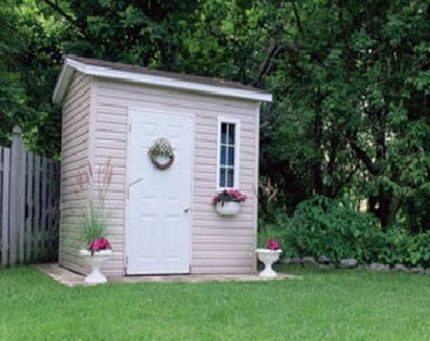
A pit without a sealed container is an environmental threat to the garden plot. If the owners of the house are interested in the cleanliness of the soil and water, they must place a tank in the pit for the cesspool.
Previously, it was made of boards or bricks, now it is made of concrete rings or monolithic concrete. Often use barrels, metal or plastic, specially designed for arranging sewers.
Even a large sealed tank of modified plastic is just a drive that quickly fills up and requires regular pumping. For this reason, cesspools are absolutely not suitable for family cottages.
To make the sewer system more efficient, a septic tank is installed instead of the cesspool, which not only collects sewage, but partially cleans it. Pumping out solid sediment from a septic tank is much less common than from a pit.
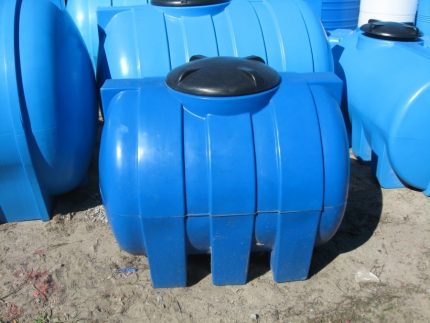
The installation is recognized as the most perfect way of collecting and processing sewer masses. biological treatment plants. Thanks to its special design and principle of operation, a unit consisting of several sections purifies the liquid up to 98%.
After such a thorough filtration, water enters the reservoir, into the ground or into the collection well for household needs.
Advantages of a Barrel Rack
If for material or other reasons you cannot install a septic tank (a more efficient sewage treatment plant), you will have to equip a cesspool.
Immediately it is worth abandoning the option that does not involve the installation of capacity. Sewer drains that have not undergone the decay process and immediately fall into the ground and groundwater contain dangerous microorganisms. Over time, they are able to pollute fertile soil, and water in the well, and cultivated plants in the garden.
Therefore, before the device of the cesspool is necessary to determine the type of tank, that is, choose one of the following options:
- brick well;
- well of concrete rings;
- rubber tire pit;
- monolithic concrete tank;
- plastic container or a metal barrel.
The cheapest, but least reliable is considered to be a well made of old car tires. It requires high-quality waterproofing and is not suitable for bulk sewage. Brick construction is too time-consuming and also requires careful sealing.
Chambers made of cast concrete are durable and easy to maintain, but require knowledge of casting technology and masterful execution. Concrete rings are popular, but their installation requires construction equipment and additional working hands.
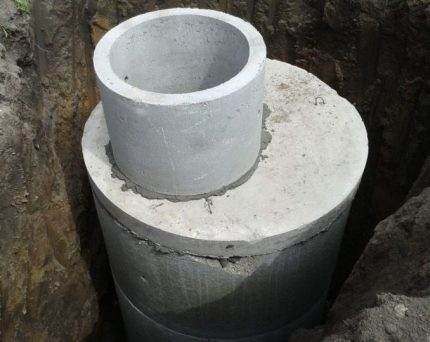
The cesspool from the barrel is easy to install, easy to maintain and has a long service life. Especially good are modern plastic sewer tanks with stiffeners and a neck for service.
For temporary needs, a metal container, additionally treated with an anti-corrosion agent, is also suitable, but it will last no more than 4-5 years.
Barrel selection for the cesspool device
In order for the cesspool to serve for a long time, does not require repair and possesses maximum functionality, it is necessary to take into account two factors in its construction: manufacturing material and volume. Let us dwell on each.
Types of containers by material
Tanks are selected based on two basic requirements for the material: strength and tightness. Metal and plastic barrels correspond to these qualities. Consider their advantages and disadvantages.
Both types are perfect for any type of soil. These are sealed containers without a filter bottom, so it makes no difference what is under the barrel - sand with high throughput or waterproof clay.
The type of soil will become important if you decide to build a more complex structure of 2 or 3 barrels, the last of which will serve as an absorbing well.
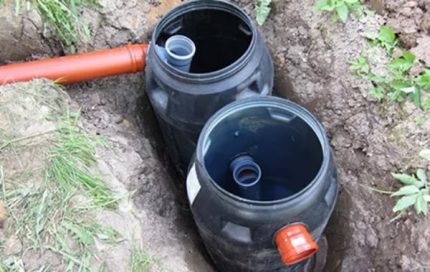
For a sealed tank, it is also unimportant where the aquifers are located. Proper observance of cesspool technology ensures safety for high groundwater. There is only one way for the waste that has got into the drive - to the cesspool of the sewer machine.
Thus, barrels made of metal and plastic combine leak tightness. If we talk about strength, then plastic products win. Modern types of plastic, designed for sewer tanks, can last up to 50 years, easily resist the effects of household chemicals, and are not susceptible to corrosion.

The only minus of plastic is freezing at very low temperatures, if the tank is close to the surface. The problem is solved by additional warming.
Disadvantages of metal barrels:
- heavy weight, causing difficulties with transportation and installation;
- the inability to withstand corrosion that can violate the tightness;
- the need for additional processing on both sides;
- the high cost of new products.
We can conclude that the best option in terms of price / quality ratio is a plastic container specially made for sewage systems.
Calculation of the volume of the cesspool
The size of the barrel depends on the volume of wastewater, and their quantity, in turn, on the number of people living in the house and the availability of water consumption points. If a married couple periodically comes to the dacha who does not use either a washing machine or a bathroom, the amount of waste will be much less than a family of 4-5 people living in the house permanently.
The easiest way to calculate capacity is to use the following formula:

Suppose 3 people live in a house, each of which has 100 liters (on average) of sewage waste daily. Under the contract, the suckers come once a month (30 days). We get 3 x 100 x 30 = 9000 liters. Consequently, a sufficiently large tank of 9 m³ is required.
If you decide to use small containers, they will require several, but for the convenience of pumping and installation it is better to purchase one large tank.
Designing and choosing a scheme
To hedge against errors in cesspool device for a summer house or a small country house, it is better to draw up a small plan and draw a diagram indicating the dimensions of the barrel, foundation pit, trenches, pipes.
The list of necessary materials and tools must include:
- plastic barrel (eurocube, tank);
- pipes and fittings for the assembly of communications;
- tool for excavation (shovel with buckets, winch, wheelbarrow);
- backfill for arranging the bottom of the pit (pebbles, gravel, crushed stone, sand).
To determine the length of the pipeline, you need to measure the distance from the building (bathhouse, garage, guest house) to the intended installation location of the barrel.
The dimensions of the pit should correspond to the size of the tank, but do not forget to leave 0.3 m on each side for backfilling. You may need to level the bottom of the pit and strengthen it with concrete pouring or a pre-prepared concrete slab.
There are several options for the construction of a cesspool from used containers (or barrels). The simplest is the installation of a single tank at a distance of 5-7 m from the house (closer is not recommended by sanitary standards). If there are several barrels, they are connected by an overflow pipe and an oblong pit is dug.

A large number of pipe joints and sections of the junction of the pipeline to the barrels increases the risk of sewage draining into the ground, so it is necessary to consider an effective way to seal joints.
Step-by-step installation instructions
Buying a factory-made sealed plastic container equipped with a hatch and attachments makes it possible to skip one rather laborious step - waterproofing the structure.
This means that the installation process will be much faster, and additional funds for the purchase of bitumen mastic or other means for sealing will not be required.
The cycle of works on the construction of a cesspool from a used metal barrel includes a number of standard stages:
When installing a septic tank from a barrel with a sealed bottom and walls in the construction of a soil filter there will be no point. The stages in these cases are reduced: they simply install a large-sized hermetic container in the foundation pit and periodically call the sewers.
The device of the pit and trenches
Digging and arranging a hole of the desired shape is the most difficult and lengthy stage. If the soil is clay, you will have to spend a lot of effort, if it is sandy, a collapse of the walls is possible, which should be temporarily fixed with a semblance of formwork. The earth raised up does not need to be transported far from the foundation pit, as part of it will be needed for backfilling.
For digging a large pit, it is better to hire a team of workers with a mini-excavator. The use of bulky equipment is a threat to country lawns and landings.
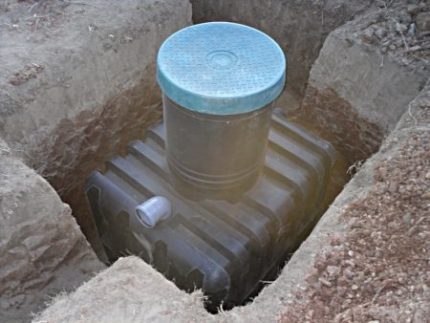
When installed on loose subsiding and heaving rocks, the bottom of the pit is reinforced to give the structure greater stability. You can use a concrete slab as a base, or you can make a cement screed with a thick drainage layer.
If the screed is not required, the bottom is covered with a layer of rubble (gravel, broken brick, pebbles), on top of it is the same layer of coarse sand. An important requirement for the foundation is compaction and alignment.
If flood waters have been noted in the area of construction of a private sewage system or, according to drilling organizations, groundwater lies close to the surface, the barrel or group of plastic containers should be anchored. Those. the structure should be fastened with a polymer cable to the metal loops monolithic in the concrete slab so that the container does not “pop up” when watering is possible.
Together with the pit, trenches for sewer communications are also being prepared. The shorter they are, the more functional the system. Pipes do not lead on the surface, but are laid at a depth of at least half a meter so that they do not freeze when the temperature drops below zero. Accordingly, the depth of the trenches should be 20-30 cm below the level of soil freezing.
Installing a barrel in a pit
If the pit is prepared correctly, installation of the tank does not take much time. The plastic container is gently lifted and transferred to the bottom of the pit so that it is exactly in the center.
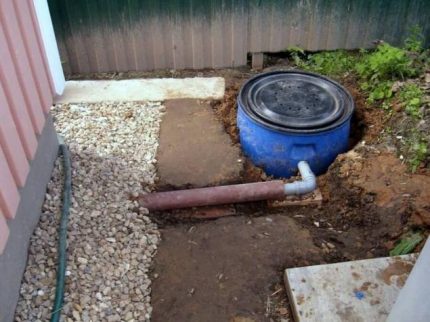
The barrel must be deployed so that the inlet for connecting the pipe is opposite it and coincides with the end of the pipe in height.
If there are several barrels, they are arranged in sequential order and connected by pipe segments, carefully sealing the joints. Even when using fittings of the right size, you should use high-quality sealant and process the places where the pipes adjoin the tank.
Connection and backfill
Together with the installation of the barrel, pipes are laid. Sewer drains will move by gravity, without the use of technical devices, so it is important to ensure a sufficient slope of about 1.5-2 cm per meter of pipe.
To connect the communications to the barrel, modern sewer tanks are equipped with a special pipe. If it is missing, you must independently cut a hole in diameter of the supply pipe.
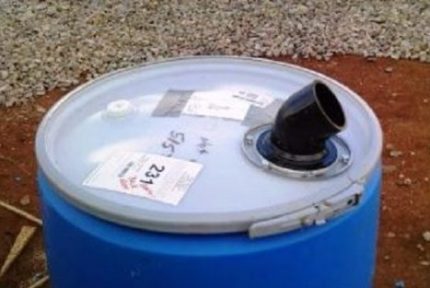
When all the connections are completed, you can start backfilling. To stabilize the tank inside the pit, dry cement is added to the soil. After setting, it forms a strong protective ring, which serves as a protective barrier against ground movement.
Backfill is performed in layers, pouring 0.2-0.3 m of sand-cement mixture and tamping each layer. The soil above the sewer pipe does not need to be compacted tightly.
If the communications are long and have branches / connections, it is better to make technical wells in the places of intersections and turns of pipes. In case of blockages, they will help to quickly find the cause.
Finishing touch - decorating the neck with a hatch. The easiest way is to break up a small flower bed. However, do not forget about the regular pumping of accumulated waste by the waste trucks, that is, about the construction of a convenient access road.
The nuances of the device pits without a bottom
A cesspool with a filter bottom is a type of ordinary cesspool. However, it is used exclusively for the collection and processing of gray effluents - water contaminated during cleaning, hygiene procedures, and cooking. It cannot be considered cumulative, because part of the sewage flows into the ground.
A gravel-sand cushion is used as a filter. Filter power in a pit with a filtering bottom should be at least 1 m. Fill in such a way that there is a sand layer 30 to 40 cm thick at the base, which is enough to clean gray wastewater from a fine suspension.
Layers of gravel or crushed stone are located higher: first a fine fraction, then a large one. They hold large impurities and clarify the water. Thus, a multi-stage purification of wastewater disposed of in the soil is performed, where it is additionally processed in natural conditions.
So that the sewage fluid does not mix with groundwater, a pit without a bottom is arranged only where their level is quite low.
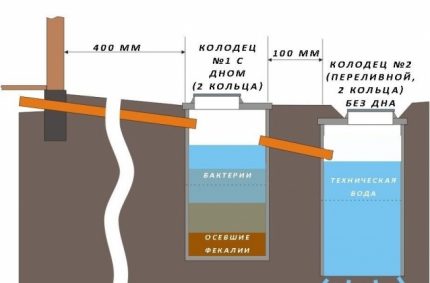
To create a cesspool without a bottom in sandy loam soils, which have extremely low filtration properties, the lower part of the walls of plastic barrels is perforated. So increase the absorption area to speed up the recycling process. True, the solid sediment will gradually clog the holes, so cleaning barrels with holes will have to be done no less than simple drives.
A home-made collection point and partial wastewater treatment needs regular maintenance using biologically active agents, which are described in our recommended article.
Conclusions and useful video on the topic
Tips for those who are interested in the proper arrangement of the cesspool.
Video # 1. Theoretical preparation for the construction of a cesspool:
Video # 2. Equipment of plastic barrels:
Video # 3. Installation and insulation of the overall capacity:
Installation of a ready-made factory model is within the power of the owner of the cottage or country house, even if he had never before been involved in the sewage system. However, before starting work, we recommend that you study the installation standards of the cesspool and seek the support of a professional with an engineering background.
Write about how you built a cesspool on your own summer cottage. Tell us about the nuances of operating an independent sewage treatment plant. Please leave comments and photos on the topic in the block under the text of the article.

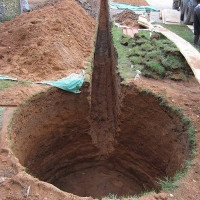 How a cesspool is constructed without a bottom: schemes and arrangement rules
How a cesspool is constructed without a bottom: schemes and arrangement rules  Plastic cesspool: how to choose a container and properly equip a plastic pit
Plastic cesspool: how to choose a container and properly equip a plastic pit 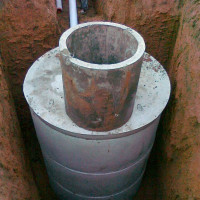 How to construct a cesspool of concrete rings: schemes + step-by-step guide
How to construct a cesspool of concrete rings: schemes + step-by-step guide 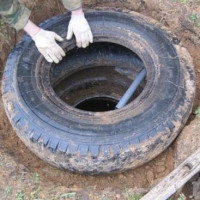 DIY drain pit from tires: step-by-step instructions for arranging
DIY drain pit from tires: step-by-step instructions for arranging 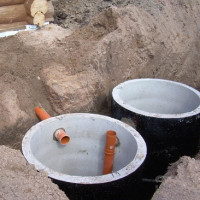 How a cesspool with overflow is arranged: schemes and construction technology
How a cesspool with overflow is arranged: schemes and construction technology 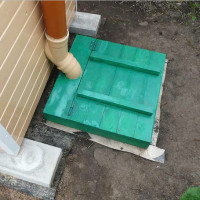 How a cesspool is constructed in a private house: a review of structures + rules for their arrangement
How a cesspool is constructed in a private house: a review of structures + rules for their arrangement  How much does it cost to connect gas to a private house: the price of organizing gas supply
How much does it cost to connect gas to a private house: the price of organizing gas supply  The best washing machines with dryer: model rating and customer tips
The best washing machines with dryer: model rating and customer tips  What is the color temperature of light and the nuances of choosing the temperature of the lamps to suit your needs
What is the color temperature of light and the nuances of choosing the temperature of the lamps to suit your needs  Replacement of a geyser in an apartment: replacement paperwork + basic norms and requirements
Replacement of a geyser in an apartment: replacement paperwork + basic norms and requirements
I live in a private house, built literally less than half a kilometer from the residential area with high-rise buildings. But the sewerage was not let down to us, only cold water. The cesspool is almost the same.A certain wide tank of medium depth is buried in the ground. I did not like this version of the drain, I often have to call the sewage system to scoop up waste water, although only drains from the kitchen sink are discharged into the cesspool. I found a solution: an ordinary drainage ditch passes near the pit, cut a hole at the top of the tank and brought the pipe into the ditch. Another disadvantage is that we have severe frosts, -30 is not so rare and wastewater, it sometimes freezes even with good insulation.
When they carried water into the house in the village with their parents, they dug a cesspool for drainage and put a plastic barrel. But they did not calculate the volume of the barrel, took less than is used. Because of this, they pump out 2 times a month. I think, is it worth changing the barrel to a larger volume or is it better to install a septic tank? Or do not bother and do as before: just leave the hole and cover it with a hatch?
Good afternoon, Alexander. The septic tank, of course, will be the most optimal solution. With an increase in volume, the cesspool will also require the call of vacuum trucks with the only difference - not twice a month, but once a month.
A cesspool without a bottom has a number of nuances that will need to be taken into account:
1. Remoteness from the foundation of the house.
2. The presence of groundwater.
3. The rate of water absorption of the soil, otherwise you will have to periodically call the machine for pumping.
You yourself will poison around you a useful space that you cannot but use. Not to mention the possible flow of sewage into a well or well. The minimum distance to which should be at least 30 meters.
Unlike these two options, a deep-septic tank will allow you to drain the treated effluents directly into the ditch. It will initially require large investments, but in the future everything will pay off.